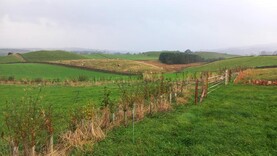A 29% cull of the suckler herd is a “a terrifying prospect that must not be entertained”, the Irish Natura and Hill Farmers Association (INHFA) has warned.
INHFA vice-president Micheal McDonnell said that rather than reducing suckler numbers, there should be a renewed appreciation for the vital role the suckler sector has in contributing to the rural economy.
McDonnell was responding to analysis in the recent Teagasc marginal abatement cost curve (MACC) report, which suggests that a 29% reduction in the suckler herd is required for the farm sector to meet its 2030 emissions target.
Sustainability
The INHFA vice-president highlighted the sustainability of the Irish suckler sector and pointed out that “despite seeing a reduction in suckler numbers over the last number of years, agriculture has still seen an increase in CO2 emissions”.
He explained that, on this basis, policy makers must recognise that further suckler herd reductions will “probably be counter-productive, as they will be offset by increases in other farming sectors”.

INHFA does not support the recent Teagasc (MACC) report which suggests that a 29% reduction in the suckler herd.
“It is essential that everyone appreciates the vital role our suckler sector is contributing in terms of support to the rural economy and its continued marketability in terms of animal welfare and sustainability,” he said.
The Mayo farmer stressed that the suckler sector’s sustainability is “evident in schemes such as the new eco scheme, where many have chosen the extensive grazing measure that requires a stocking density of less than 1.2LU/ha.”
“If we are serious about supporting sustainable farming practices, then any farmer with a stocking rate below this level must be exempted from any reduction,” he added.
New scheme
McDonnell also insisted that the new national suckler scheme, which will replace the Beef Environmental Efficiency Programme (BEEP), must be accessible to all suckler farmers and that should have the sufficient funding to make this possible.
“It must also have measures that are accessible to all farmers and while there has been talk of a payment rate of €60/cow, we would like to see that increased and definitely believe a higher rate should be paid on the first 10 cows,” he added.
In conclusion, the INHFA vice-president noted that “suckler-branded beef has massive growth potential due to the combination of sustainable environmental practices and favourable welfare practices that keeps the calf with its mother”.
Read more
Time to back or sack the Teagasc MACC?
MACC plan - time for suckler farmer fight back?
A 29% cull of the suckler herd is a “a terrifying prospect that must not be entertained”, the Irish Natura and Hill Farmers Association (INHFA) has warned.
INHFA vice-president Micheal McDonnell said that rather than reducing suckler numbers, there should be a renewed appreciation for the vital role the suckler sector has in contributing to the rural economy.
McDonnell was responding to analysis in the recent Teagasc marginal abatement cost curve (MACC) report, which suggests that a 29% reduction in the suckler herd is required for the farm sector to meet its 2030 emissions target.
Sustainability
The INHFA vice-president highlighted the sustainability of the Irish suckler sector and pointed out that “despite seeing a reduction in suckler numbers over the last number of years, agriculture has still seen an increase in CO2 emissions”.
He explained that, on this basis, policy makers must recognise that further suckler herd reductions will “probably be counter-productive, as they will be offset by increases in other farming sectors”.

INHFA does not support the recent Teagasc (MACC) report which suggests that a 29% reduction in the suckler herd.
“It is essential that everyone appreciates the vital role our suckler sector is contributing in terms of support to the rural economy and its continued marketability in terms of animal welfare and sustainability,” he said.
The Mayo farmer stressed that the suckler sector’s sustainability is “evident in schemes such as the new eco scheme, where many have chosen the extensive grazing measure that requires a stocking density of less than 1.2LU/ha.”
“If we are serious about supporting sustainable farming practices, then any farmer with a stocking rate below this level must be exempted from any reduction,” he added.
New scheme
McDonnell also insisted that the new national suckler scheme, which will replace the Beef Environmental Efficiency Programme (BEEP), must be accessible to all suckler farmers and that should have the sufficient funding to make this possible.
“It must also have measures that are accessible to all farmers and while there has been talk of a payment rate of €60/cow, we would like to see that increased and definitely believe a higher rate should be paid on the first 10 cows,” he added.
In conclusion, the INHFA vice-president noted that “suckler-branded beef has massive growth potential due to the combination of sustainable environmental practices and favourable welfare practices that keeps the calf with its mother”.
Read more
Time to back or sack the Teagasc MACC?
MACC plan - time for suckler farmer fight back?







 This is a subscriber-only article
This is a subscriber-only article










SHARING OPTIONS: